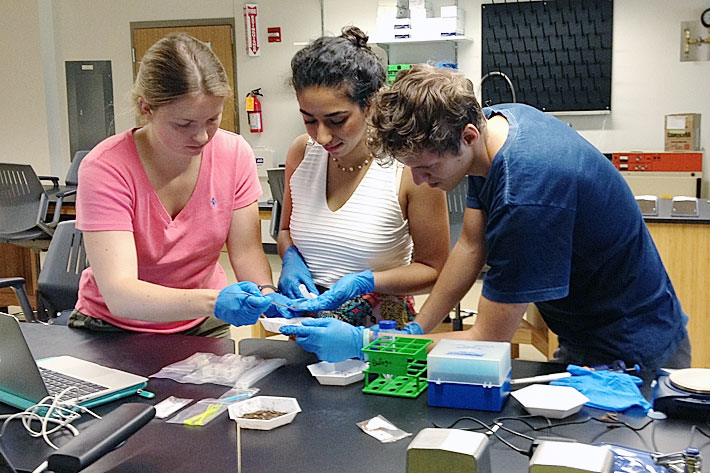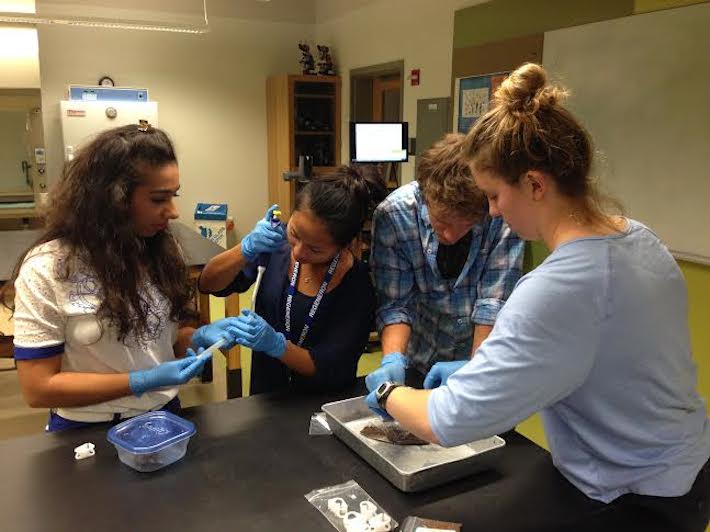A science project designed by two George Washington University students finally reached the International Space Station (ISS) on Monday morning.
SpaceX's Falcon 9 rocket carrying the Dragon—a supply ship loaded with groceries, belated Christmas presents and 18 student experiments—lifted off at 4:47 a.m. Jan. 10 from Cape Canaveral, Fla.
Shayda Shahbazi and Xixi Ni, both seniors in the School of Engineering and Applied Science, watched their original experiment perish in October, when an unmanned rocket carrying the project exploded. Over the next few weeks, the students scrambled to assemble a new test tube (or “mini-lab”) to send to space.
Another rocket was set to launch on Jan. 6, but officials halted the liftoff countdown with just over a minute remaining due to a mechanical failure. Six days later, when Ms. Shahbazi received an email saying, “the Dragon was successfully captured and berthed with the International Space Station this morning," she exhaled with a sigh of relief.
“Working through numerous setbacks made the success that much sweeter,” she said. “I'm eager to begin the next phase of the project when the mini-lab returns to Earth.”
Ms. Shahbazi and Ms. Ni are both members of the D.C. Space Grant Consortium Program, which provides stipends and training as encouragement for local college students to become science, technology, engineering and math (STEM) teachers.
As part of the program’s curriculum, the SEAS students collaborated with two Georgetown undergraduates to build a science project for the Flight Experiment Design Competition. The competition challenges youth and college students to design an experiment and vie for the chance to send it to astronauts on the ISS.
The GW/Georgetown team was overjoyed when its proposal was one of 18 chosen from more than 1,400 entries.

Shayda Shahbazi (center), a senior in the School of Engineering and Applied Science, works with her two Georgetown teammates to prepare their science experiment for the International Space Station. The students are interested to find out whether chrysanthemum plant seeds can germinate in space and potententially be used to remove harmful toxins from the air on spacecrafts.
The students are finding out whether chrysanthemum plant seeds can germinate in space. Previous research has shown that chrysanthemums can purify and remove harmful toxins from the air. So the plants could potentially prevent disease in astronauts who are susceptible to indoor air pollution on an enclosed spacecraft.
But in order to last on a long-term space mission, chrysanthemum seeds must be able to germinate in microgravity conditions. To answer their research question, the students fill a plastic test tube, called a mini-lab, with seeds, distilled water and potting mix. An astronaut on the ISS will initiate the experiment by turning the tube and beginning the germination process.
Following the Antares rocket explosion in October, Ms. Shahbazi and her teammates received a new mini-lab from Nanoracks, the company that creates hardware to send into space, in mid-November. The students re-loaded the mini-lab with their materials and video-conferenced space industry experts at NanoRacks, who walked the team through the proper steps for prepping the test tube for flight.
The Dragon is expected to remain docked on the ISS for about a month before returning to Earth and bringing with it the students’ mini-lab. If the seeds have germinated within the tube, then the students will plant them on Earth and compare them to chrysanthemums grown from seeds that germinated on Earth. The students will compare the growth rates of the two groups to determine the role of gravity in plant biology.
It's been nearly a year since the students first developed their research question. In that time, Ms. Ni has waited anxiously for her experiment to find its way into Earth’s orbit, but she said the wait was well worth it.
“It's still sinking in," she said. "I just feel really blessed that I’m able to have this experience.”
Ms. Shahbazi said that the obstacles her team faced only made her a stronger scientist.
“After several launch slips and myriad emails, I've learned that patience and adaptability are critical to experimentation.”



